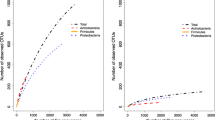Abstract
This report describes a new group of anaerobic bacteria that degrade oxalic acid. The new genus and species, Oxalobacter formigenes, are inhabitants of the rumen and also of the large bowel of man and other animals where their actions in destruction of oxalic acid may be of considerable importance to the host. Isolates from the rumen of a sheep, the cecum of a pig, and from human feces were all similar Gram-negative, obligately anaerobic rods, but differences between isolates in cellular fatty acid composition and in serologic reaction were noted. Measurements made with type strain OxB indicated that 1 mol of protons was consumed per mol of oxalate degraded to produce approximately 1 mol of CO2 and 0.9 mol of formate. Substances that replaced oxalate as a growth substrate were not found.
Similar content being viewed by others
References
Allison MJ, Cook HM (1981) Oxalate degradation by microbes of the large bowel of herbivores: the effect of dietary oxalate. Science 212:675–676
Allison MJ, Cook HM, Dawson KA (1981) Selection of oxalate-degrading rumen bacteria in continuous culture. J Anim Sci 53:810–816
Allison MJ, Littledike ET, James LF (1977) Changes in ruminal oxalate degradation rates associated with adaptation to oxalate ingestion. J Anim Sci 45:1173–1179
Allison MJ, Reddy CA (1984) Adaptations of gastrointestinal bacteria in response to changes in dietary oxalate and nitrate. In: Reddy CA, Klug MJ (eds) Current perspectives on microbial ecology. Amer Soc Microbiology, Washington, DC, pp 248–256
Allison MJ, Robinson IM, Bucklin JA, Boot GD (1979) Comparison of bacterial populations of the pig cecum and colon based upon enumeration with specific energy sources. Appl Environ Microbiol 37:1142–1151
Barber HH, Gallimore EJ (1940) The metabolism of oxalic acid in the animal body. Biochem J 34:144–148
Bryant MP (1972) Commentary on the Hungate technique for culture of anaerobic bacteria. Am J Clin Nutr 25:1324–1328
Bryant MP, Burkey LA (1953) Cultural methods and some characteristics of some of the more numerous groups of bacteria in the bovine rumen. J Dairy Sci 36:205–217
Buckel W, Semmler R (1982) A biotin-dependent sodium pump: glutaconyl-CoA decarboxylase from Acidaminococcus fermentans. FEBS Lett 148:35–38
Caldwell DR, Bryant MP (1966) Medium without rumen fluid for the nonselective enumeration and isolation of rumen bacteria. Appl Microbiol 14:794–801
Chandra TS, Shethna YI (1975) Isolation and characterization of some new oxalate decomposing bacteria. Antonie van Leeuwenhoek 41:101–111
Dawson KA, Allison MJ, Hartman PA (1980a) Isolation and some characteristics of anaerobic oxalate-degrading bacteria from the rumen. Appl Environ Microbiol 40:833–839
Dawson KA, Allison MJ, Hartman PA (1980b) Characteristics of anaerobic oxalate-degrading enrichment cultures from the rumen. Appl Environ Microbiol 40:840–846
Dimroth P (1982) The generation of an electrochemical gradient of sodium ions upon decarboxylation of oxaloacetate by the membrane-bound and Na+-activated oxaloacetate by the ase from Klebsiella aerogenes. Eur J Biochem 121:443–449
Edwards PR, Ewing WH (1955) Identification of enterobacteriaceae. Burgess Publishing Co., Minneapolis, MN
Hagmaier V, Hornig D, Bannwart C, Schmidt K, Weber F, Graf H, Rutishauser G (1981) Decomposition of exogenous 14C-oxalate (14C-OX) to 14C-carbon dioxide (14CO2) in vitro and in animals. In: Smith LH, Robertson WG, Finlayson B (eds) Urolithiasis clinical and basic research. Plenum Press, New York, pp 875–879
Heddleston KL, Gallagher JE, Rebers PA (1972) Fowl cholera: gel diffusion precipitin test for serotyping Pasteurella multocida from avian species. Avian Dis 16:925–936
Hilpert W, Dimroth P (1982) Conversion of the chemical energy of methyl-malonyl-CoA decarboxylation into a Na+ gradient. Nature 296:584–585
Hodgkinson A (1977) Oxalic acid in biology and medicine. Academic Press, Inc., New York
Holdeman LV, Cato EP, Moore WEC (1977) Anaerobe laboratory manual, 4th ed, Virginia Polytechnic and State University, Blacksburg, VA, USA
Lankhorst A, Counotte GHM, Koopman JP, Prins RA (1979) Rapid characterization of mixed microbial populations in ruminal contents, cecal contents and in feces by a semi-quantitative assay of some hydrolytic enzymes (API ZYME). Z Tierphysiol 41:162–171
Marmur J, Doty P (1962) Determination of the base composition of deoxyribonucleic acid from its thermal denaturation temperature. J Mol Biol 5:109–118
Mayberry WR (1980) Hydroxy fatty acids in Bacteroides species: d-(-)-3-hydroxy-15-methylhexadecanoate and its homologs. J Bacteriol 143:582–587
Mayberry WR (1981) Dihydroxy and monohydroxy fatty acids in Legionella pneumophila. J Bacteriol 147:373–381
Morris MP, Garcia-Rivera J (1955) The destruction of oxalate by rumen contents of cows. J Dairy Sci 38:1169
Pfennig N, Lippert KD (1966) Über das Vitamin-B12-Bedürfnis phototropher Schwefelbakterien. Arch Mikrobiol 55:245–256
Postgate JR (1963) A strain of Desulfovibrio able to use oxamate. Arch Mikrobiol 46:287–295
Quayle JR, Keech DB (1959) Carbon assimilation by Pseudomonas oxalaticus (Ox1) 2. Formate and carbon dioxide utilization by cell-free extracts of the organism grown on formate. Biochem J 72:631–637
Quayle JR, Keech DB, Taylor GA (1961) Carbon assimilation by Pseudomonas oxalaticus (Ox1) 4. Metabolism of oxalate in cell-free extracts of the organism grown on oxalate. Biochem J 78:225–236
Schink B, Pfennig N (1982) Propionigenium modestum gen. nov. sp. nov. A new strictly anaerobic nonsporing bacterium growing on succiante. Arch Microbiol 133:209–216
Shirley EK, Schmidt-Nielsen K (1967) Oxanate metabolism in the packrat, sand rat, hamster, and white rat. J Nutr 91:496–502
Smith RL, Oremland RS (1983) Anaerobic oxalate degradation: widespread natural occurrence in aquatic sediments. Appl Environ Microbiol 46:106–113
Smith RL, Strohmaier FE, Oremland RS (1984) Isolation of anaerobic oxalate-degrading bacteria from freshwater lake sediments. Arch Microbiol (subumitted for publication)
Talapatra SK, Ray SC, Sen KC (1948) Calcium assimilation in ruminants on oxalate-rich diet. J Agri Sci 38:163–173
Watts PS (1957) Decomposition of oxalic acid in vitro by rumen contents. Aust J Agric Res 8:266–270
Zehnder AJB, Brock TD (1979) Biological energy production in the apparent absence of electron transport and substrate level phosphorylation. FEBS Lett 107:1–3
Author information
Authors and Affiliations
Rights and permissions
About this article
Cite this article
Allison, M.J., Dawson, K.A., Mayberry, W.R. et al. Oxalobacter formigenes gen. nov., sp. nov.: oxalate-degrading anaerobes that inhabit the gastrointestinal tract. Arch. Microbiol. 141, 1–7 (1985). https://doi.org/10.1007/BF00446731
Received:
Accepted:
Issue Date:
DOI: https://doi.org/10.1007/BF00446731



